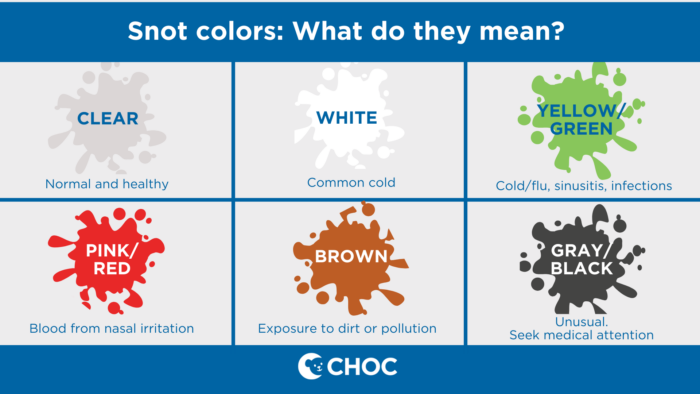What the color of your child’s mucus can say about their health
Especially during cold and flu season, it’s common for kids to have sniffles and runny noses. As a parent, of course, you want to do everything you can to help your child feel better when they are sick.
Luckily, the color of your child’s snot (mucus) can give you helpful clues about how your child is feeling. Not all mucus colors indicate a serious issue, but understanding the different shades can help you determine when and if you should call the doctor.
Here, Dr. Angela Allevato, a CHOC pediatrician, decodes various snot colors and what they may be able to tell you about your child’s health.
What your child’s snot color can say about their health
Mucus (also known as snot) is a sticky, slimy substance that lines the nose, upper airway and digestive tract. It serves as the first line of defense against unwelcome bacteria, dirt or viruses from the air that may try to enter the body through the lungs.

 Print this
Print this
Clear mucus (snot)
Clear snot, also known as nasal discharge, is considered normal and healthy— it’s a sign of a healthy immune system. Clear snot will look clear in color and be a runny, sticky substance.
However, if your child seems to have excessive clear snot, it could be a symptom of seasonal allergies or “hay fever,” or be a sign that your child is developing a cold or other virus.
White mucus (snot)
White mucus is generally a sign of a common cold or viral infection. White mucus may look cloudier and clumpier than clear mucus and can indicate that the immune system is doing its job — trapping and expelling the virus from the body.
In most cases, rest, hydration and over-the-counter remedies can help alleviate symptoms. If the clear or white mucus persists for more than a week or is accompanied by other symptoms of illness, consult your pediatrician.
Yellow or green mucus (snot)
Yellow, yellowish-gray or green mucus can be an indication that the body is fighting off a viral or bacterial infection. The color change occurs as white blood cells, responsible for battling infection, gather in the mucus.
Viral and bacterial infections that may cause yellow or green snot include:
While yellow or green mucus may suggest a more severe infection, such as bronchitis or sinusitis, it doesn’t always mean your child needs antibiotics.
We often recommend watching for other symptoms like persistent fever or worsening symptoms before prescribing antibiotics, says Dr. Allevato.
If your child has yellow or green mucus for 10 days or more, call your pediatrician during normal business hours.
Red or pink mucus (snot)
If you notice red or pink streaks in your child’s mucus, it could be a sign of blood. Common causes include nasal irritation from dry air, excessive nose picking or minor injuries to the nose.
However, if the bleeding is constant or severe, call your pediatrician or urgent care.
Brown mucus (snot)
Brown mucus may be a result of environmental factors, such as exposure to dirt or pollution.
It can also occur in children following red or pink snot, as the blood can mix with mucus and give it a brownish tint. In rare cases, brown mucus may be a sign of a fungal infection.
If the brown color persists or is accompanied by other concerning symptoms, call your pediatrician.
Black or dark gray mucus (snot)
Black or dark gray mucus is unusual and should prompt immediate medical attention.
It could be a sign of a fungal infection, mold exposure, or, in rare cases, the presence of a foreign object in the nose. Contact your pediatrician right away if you your child has black or dark gray mucus.
When to seek medical attention
While the color of your child’s snot can provide some clues about their health, it’s important to consider other factors such as the duration of symptoms, fever, cough, and overall well-being of your child. If your child has any color of mucus (besides clear) for a prolonged amount of time, give your pediatrician a call.
Remember, you know your child best! If you’re ever unsure or if your child’s symptoms are worsening or lasting a long time, call your pediatrician. They can provide personalized advice based on your child’s specific situation and ensure they receive the care they need.
For more health and wellness resources from the pediatric experts at CHOC, sign up for the Kids Health newsletter.
Find a CHOC Primary Care Pediatrician
From babies to teens, pediatricians from CHOC’s Primary Care Network partner with parents to offer immunizations, sick visits, sports physicals and more.





